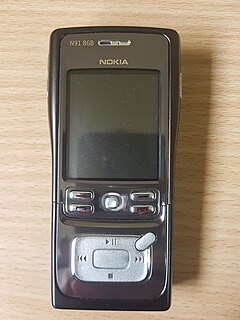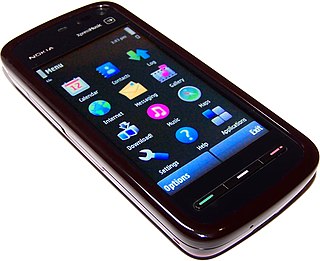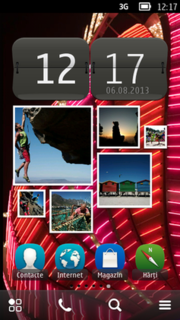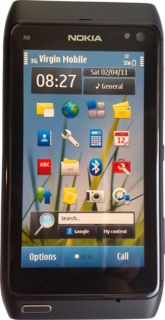
The Nokia N91 is a smartphone produced by Nokia as part of their Nseries line of portable devices. It was announced on April 27, 2005 along with N70 and N90 as the first three Nseries devices. The N91 ran on Symbian-based S60 3rd Edition. It was the first ever phone encompassing a 4 GB internal hard drive, allowing storage for 3,000 songs. The N91 is highly focused on music,. with dedicated music keys on the front which slide down to reveal the keypad. It also featured the industry-standard 3.5 mm headphone jack, and was anticipated as a major challenger to Apple, whose iPod dominated the industry. The design of the N91 is based on stainless steel with a matte finish.

The Nokia N70 is a 3G smartphone from Nokia. It was announced as part of the Nokia's new line of multimedia smartphones, the Nseries, on April 27, 2005. It started shipping in September 2005. It runs on the S60 2nd Edition, Feature Pack 3 on Symbian v8.1 operating system. It was succeeded by the Nokia N73. The N70 was popular and sold well.
The Nokia Communicator is a brand name for a series of business-optimized smartphones marketed by Nokia Corporation, all of which appear as normal phones on the outside, and open in clamshell format to access a QWERTY keyboard and an LCD screen nearly the size of the device footprint.
Nokia Browser for Symbian was the default web browser for the S60 and Symbian mobile phone platform. The browser is based on a port of Apple Inc.'s open-source WebCore and JavaScriptCore frameworks which form the WebKit rendering engine that Apple uses in its Safari Web browser.

The Nokia N95 is a smartphone produced by Nokia as part of their Nseries line of portable devices. Announced in September 2006, it was released to the market in March 2007. The N95 ran S60 3rd Edition, on Symbian OS v9.2. It has a two-way sliding mechanism, which can be used to access either media playback buttons or a numeric keypad. It was first released in silver and later on in black, with limited edition quantities in gold and purple. The launch price of the N95 was around €550.

The Nokia N73 is a smartphone announced by Nokia on 2006 & Music Edition 2007, as part of the Nseries and started shipping on 15 July. The N73 succeeded the N70 and packed in numerous multimedia features. It features a 3.2 megapixel autofocus camera, a front camera, a then-large 2.4-inch display, and stereo speakers, all in a relatively slim and pocketable size and form. It runs on Symbian v9.1.

Nokia 8110 is a mobile phone released in 1996. It was announced on September 9, 1996, as the first of Nokia's high-end 8000 series of phones. Its distinctive styling was the first example of a 'slider' form factor. A sliding cover protected the keypad when being carried in the pocket and extended downwards in use, bringing the microphone closer to the mouth. The action of opening the cover also answered an incoming call. The prominent curvature of the case, particularly when open, earned it the nickname "banana phone". It was also the first Nokia phone with monochrome graphic LCD.

Nokia 5800 XpressMusic is a smartphone part of the XpressMusic line, announced by Nokia on 2 October 2008 in London and started shipping in November of that year. Code-named "Tube", it was the first touchscreen-equipped S60 device by Nokia - essentially it was the first device to run Symbian^1, also known as S60 5th Edition, the touch-specific S60-based platform created by the Symbian Foundation. The touchscreen features tactile feedback.

The Nokia N97 is a high-end smartphone introduced on 2 December 2008 by telecommunications manufacturer Nokia as part of its Nseries and released in June 2009 as the successor to the Nokia N96 phone. The N97 was Nokia's second S60-based touchscreen phone, after the Nokia 5800 XpressMusic. The device featured slide-out QWERTY keyboard, and ran on the Symbian v9.4 operating system. Its design took cues from the Nokia N79. A smaller 'mini' version was later released.

The Nokia N86 8MP is a high-end smartphone with emphasis on the camera. It was announced on 17 February 2009 and released in May 2009 as part of the Nseries. It runs on Symbian OS 9.3 and shares similar design features with the N97. Its name references the camera's megapixel count.

The Nokia X6 is a music-oriented capacitive touchscreen smartphone and portable entertainment device by Nokia. It was announced in early September 2009 during Nokia World 2009 in Germany.
Nokia SU-33W is a Nokia's Mobile TV Receiver. With this optional DVB-H it is possible to watch television on the screen of the phone. Many Nokia mobile phones with Bluetooth are compatible.

Symbian is a discontinued mobile operating system (OS) and computing platform designed for smartphones. Symbian was originally developed as a proprietary software OS for PDAs in 1998 by the Symbian Ltd. consortium. Symbian OS is a descendant of Psion's EPOC, and was released exclusively on ARM processors, although an unreleased x86 port existed. Symbian was used by many major mobile phone brands, like Samsung, Motorola, Sony Ericsson, and above all by Nokia. It was also prevalent in Japan by brands including Fujitsu, Sharp and Mitsubishi. As a pioneer that established the smartphone industry, it was the most popular smartphone OS on a worldwide average until the end of 2010, at a time when smartphones were in limited use, when it was overtaken by iOS and Android. It was notably less popular in North America.

The Nokia C6-00 is a smartphone and portable entertainment handheld cellular device by Finnish communications company Nokia, running the Symbian S60v5 operating system. It was announced on April 13, 2010. It is the third Nokia Symbian^1 smartphone featuring a full slide-out QWERTY keyboard. Its software and hardware specifications resemble the N97 mini in most ways. One of the differences is that the sliding in this phone is flat, unlike the upward angled in the N97 mini, hence allowing a four row QWERTY keypad, bringing a slightly enhanced typing experience to the table. The phone has a 5-megapixel camera, though unlike the N97 mini, it does not have Carl Zeiss optics. It also has a secondary camera in front for video calls. The Nokia C6-01 is the successor to the C6-00 featuring a major step-up with the new Symbian^3 operating system, Ovi Maps 3.0 and such but losing the QWERTY keyboard.

The Nokia N8 is a touchscreen-based smartphone developed by Nokia. Announced on 27 April 2010, the Nokia N8 was the first device to run on the Symbian^3 mobile operating system and it was the company's flagship device for the year. It was released on 30 September 2010 at the Nokia Online Store before being released in markets around the world on 1 October 2010. There were two version made, the N8 and the N8-00. The N8 was made for Vodafone and locked to its networks, and the N8-00 was made by Microsoft and open network.
The Nokia E7-00, also known as Nokia E7, is a business-oriented QWERTY smartphone by Nokia from the Nokia Eseries. It was announced at Nokia World in September 2010 together with the Nokia C6-01 and Nokia C7 and started shipping in February 2011. It is the second phone after the Nokia N8 to be running the Symbian^3 operating system.

The Nokia Nseries was a lineup of smartphones and tablets marketed by Nokia Corporation from 2005 to 2011. The Nseries devices commonly supported multiple high-speed wireless technologies at the time, such as 3G, or Wireless LAN. Digital multimedia services, such as music playback, photo/video capture or viewing, gaming or internet services were the central focus of the lineup. The lineup was replaced in 2011 by the Nokia Lumia line as the company's primary smartphone lineup.
Nokia's strategic nomenclature can be traced back in 2005 when the Nseries line was launched, offering devices with flagship specifications and premium hardware at various price points. These devices were considered the "bread and butter" of the company and were often positioned to showcase their latest technologies. Thanks to the newfound consumer and enterprise interest in smartphones at the time, the company introduced four additional collections to diversify their product portfolio and meet demands in most market segments. These new phone series were named Eseries, targeting small business and enterprise customers; Xseries, providing consumer-grade multimedia-focused devices; Cseries, which Nokia used to target both the low-end and mid-range market segments; and Tseries, for devices exclusive to the Chinese market.
Nokia Mail and Nokia Chat were services developed by Microsoft Mobile and earlier by Nokia for its mobile phones. The service operated as a centralized, hosted service that acted as a proxy between the Messaging client and the user's e-mail server. The phone did not connect directly to the e-mail server, but instead sent e-mail credentials to Nokia's servers. On 13 August 2008 Nokia launched a beta release of "Nokia Email service", a push e-mail service, later incorporated into Nokia Messaging. The original version of Nokia Messaging was launched in 2008 with the Nokia N97 line of smartphones and was exclusive to Finland, the United Kingdom, the Netherlands, Germany, Spain, Singapore, Australia and Venezuela before being expanded to other countries and was exclusive to Symbian handsets, Series 40 support was announced for 2009. The first public version of Nokia Messaging supports Windows Live Hotmail accounts, Yahoo! accounts, and Google accounts and was available in 12 languages.

HERE WeGo is a web mapping and navigation service, operated by Here Technologies and originally developed by Nokia. In 2013, HERE Technologies released this web mapping application for Windows Phone and the World Wide Web as a revamped version of Nokia Maps. HERE Technologies released the HERE Maps application to the Android platform on 10 December 2014 and later for iOS on 11 March 2015. The company changed the product name to Here WeGo in July 2016. It's the default maps service provider for the Amazon Fire tablets and smartphone.













